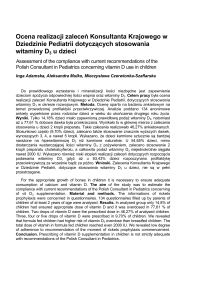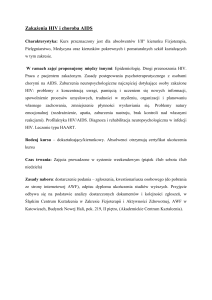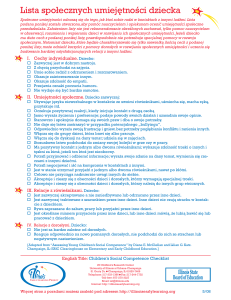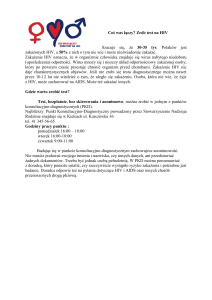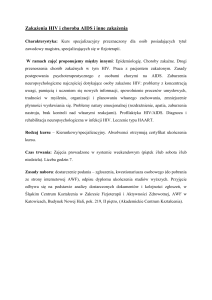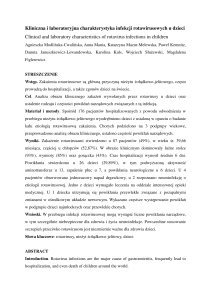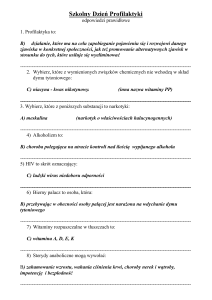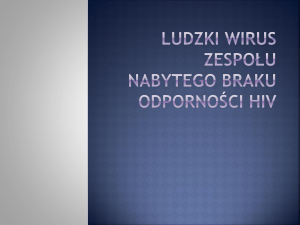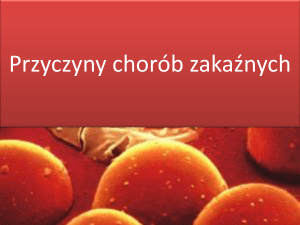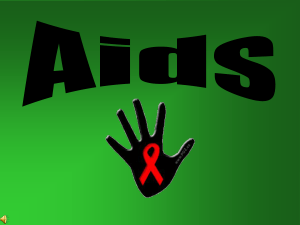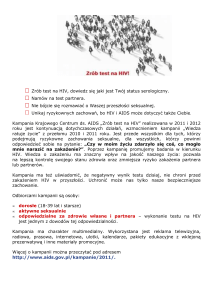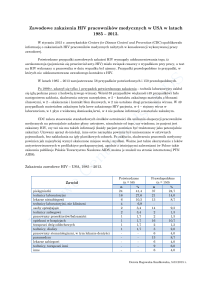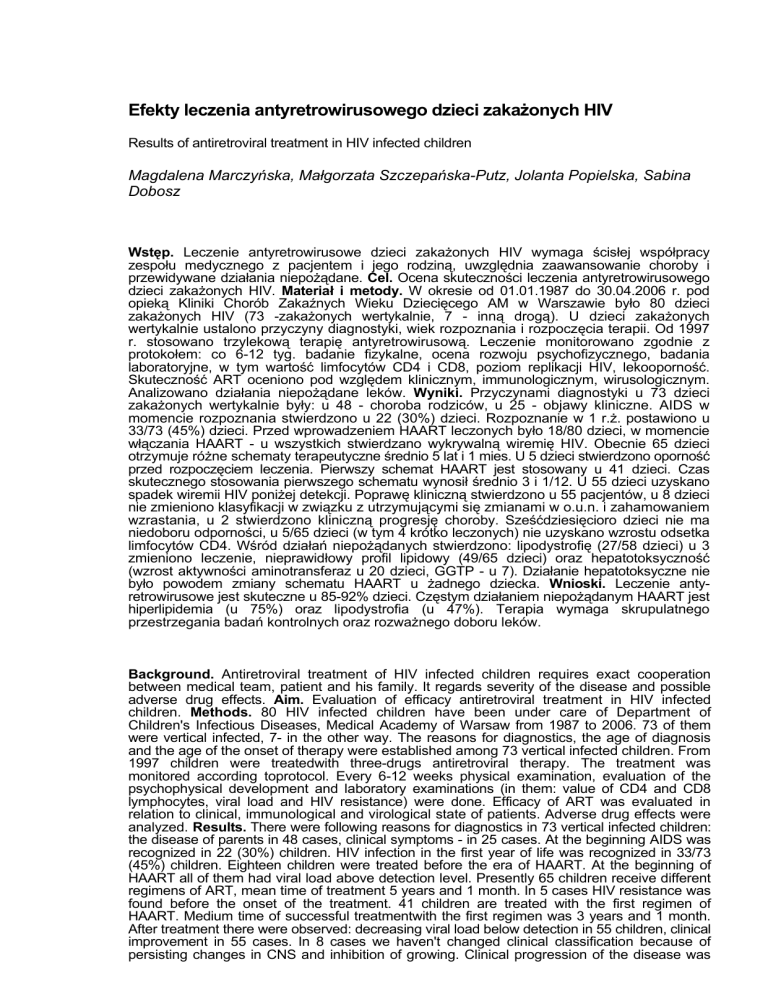
Efekty leczenia antyretrowirusowego dzieci zakażonych HIV
Results of antiretroviral treatment in HIV infected children
Magdalena Marczyńska, Małgorzata Szczepańska-Putz, Jolanta Popielska, Sabina
Dobosz
Wstęp. Leczenie antyretrowirusowe dzieci zakażonych HIV wymaga ścisłej współpracy
zespołu medycznego z pacjentem i jego rodziną, uwzględnia zaawansowanie choroby i
przewidywane działania niepożądane. Cel. Ocena skuteczności leczenia antyretrowirusowego
dzieci zakażonych HIV. Materiał i metody. W okresie od 01.01.1987 do 30.04.2006 r. pod
opieką Kliniki Chorób Zakaźnych Wieku Dziecięcego AM w Warszawie było 80 dzieci
zakażonych HIV (73 -zakażonych wertykalnie, 7 - inną drogą). U dzieci zakażonych
wertykalnie ustalono przyczyny diagnostyki, wiek rozpoznania i rozpoczęcia terapii. Od 1997
r. stosowano trzylekową terapię antyretrowirusową. Leczenie monitorowano zgodnie z
protokołem: co 6-12 tyg. badanie fizykalne, ocena rozwoju psychofizycznego, badania
laboratoryjne, w tym wartość limfocytów CD4 i CD8, poziom replikacji HIV, lekooporność.
Skuteczność ART oceniono pod względem klinicznym, immunologicznym, wirusologicznym.
Analizowano działania niepożądane leków. Wyniki. Przyczynami diagnostyki u 73 dzieci
zakażonych wertykalnie były: u 48 - choroba rodziców, u 25 - objawy kliniczne. AIDS w
momencie rozpoznania stwierdzono u 22 (30%) dzieci. Rozpoznanie w 1 r.ż. postawiono u
33/73 (45%) dzieci. Przed wprowadzeniem HAART leczonych było 18/80 dzieci, w momencie
włączania HAART - u wszystkich stwierdzano wykrywalną wiremię HIV. Obecnie 65 dzieci
otrzymuje różne schematy terapeutyczne średnio 5 lat i 1 mies. U 5 dzieci stwierdzono oporność
przed rozpoczęciem leczenia. Pierwszy schemat HAART jest stosowany u 41 dzieci. Czas
skutecznego stosowania pierwszego schematu wynosił średnio 3 i 1/12. U 55 dzieci uzyskano
spadek wiremii HIV poniżej detekcji. Poprawę kliniczną stwierdzono u 55 pacjentów, u 8 dzieci
nie zmieniono klasyfikacji w związku z utrzymującymi się zmianami w o.u.n. i zahamowaniem
wzrastania, u 2 stwierdzono kliniczną progresję choroby. Sześćdziesięcioro dzieci nie ma
niedoboru odporności, u 5/65 dzieci (w tym 4 krótko leczonych) nie uzyskano wzrostu odsetka
limfocytów CD4. Wśród działań niepożądanych stwierdzono: lipodystrofię (27/58 dzieci) u 3
zmieniono leczenie, nieprawidłowy profil lipidowy (49/65 dzieci) oraz hepatotoksyczność
(wzrost aktywności aminotransferaz u 20 dzieci, GGTP - u 7). Działanie hepatotoksyczne nie
było powodem zmiany schematu HAART u żadnego dziecka. Wnioski. Leczenie antyretrowirusowe jest skuteczne u 85-92% dzieci. Częstym działaniem niepożądanym HAART jest
hiperlipidemia (u 75%) oraz lipodystrofia (u 47%). Terapia wymaga skrupulatnego
przestrzegania badań kontrolnych oraz rozważnego doboru leków.
Background. Antiretroviral treatment of HIV infected children requires exact cooperation
between medical team, patient and his family. It regards severity of the disease and possible
adverse drug effects. Aim. Evaluation of efficacy antiretroviral treatment in HIV infected
children. Methods. 80 HIV infected children have been under care of Department of
Children's Infectious Diseases, Medical Academy of Warsaw from 1987 to 2006. 73 of them
were vertical infected, 7- in the other way. The reasons for diagnostics, the age of diagnosis
and the age of the onset of therapy were established among 73 vertical infected children. From
1997 children were treatedwith three-drugs antiretroviral therapy. The treatment was
monitored according toprotocol. Every 6-12 weeks physical examination, evaluation of the
psychophysical development and laboratory examinations (in them: value of CD4 and CD8
lymphocytes, viral load and HIV resistance) were done. Efficacy of ART was evaluated in
relation to clinical, immunological and virological state of patients. Adverse drug effects were
analyzed. Results. There were following reasons for diagnostics in 73 vertical infected children:
the disease of parents in 48 cases, clinical symptoms - in 25 cases. At the beginning AIDS was
recognized in 22 (30%) children. HIV infection in the first year of life was recognized in 33/73
(45%) children. Eighteen children were treated before the era of HAART. At the beginning of
HAART all of them had viral load above detection level. Presently 65 children receive different
regimens of ART, mean time of treatment 5 years and 1 month. In 5 cases HIV resistance was
found before the onset of the treatment. 41 children are treated with the first regimen of
HAART. Medium time of successful treatmentwith the first regimen was 3 years and 1 month.
After treatment there were observed: decreasing viral load below detection in 55 children, clinical
improvement in 55 cases. In 8 cases we haven't changed clinical classification because of
persisting changes in CNS and inhibition of growing. Clinical progression of the disease was
recognized in 2 children. 60 children has no immunosuppression. 5/65 children (4 of them shortly treated) have immunosuppression. Adverse drug effects were observed: lipodystrophy
(27/58 children), 3 of them have changed the regimen of ART, abnormal lipids profile (49/65
children) and hepatotoxicity (increased level of aminotranspherases in 20 children, GGTP - in
7 cases). There were no ART changes because of hepatotoxicity. Conclusions. Antiretroviral
treatment was successful in 85-92% children. Frequent adverse drug effects were: abnormal
levels of lipids (75%) and lipodystrophy (47%). The therapy requires precise complying with
control examinations and deliberate selection of drugs.

